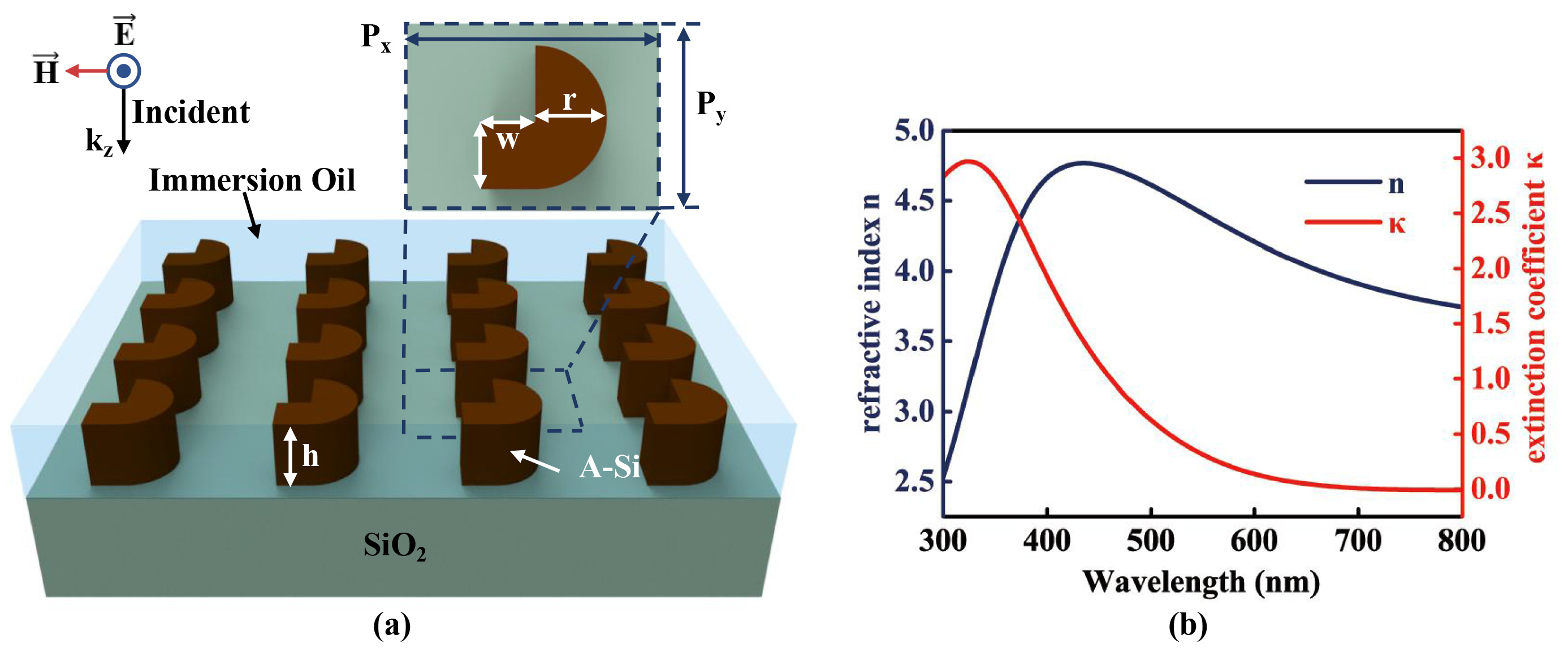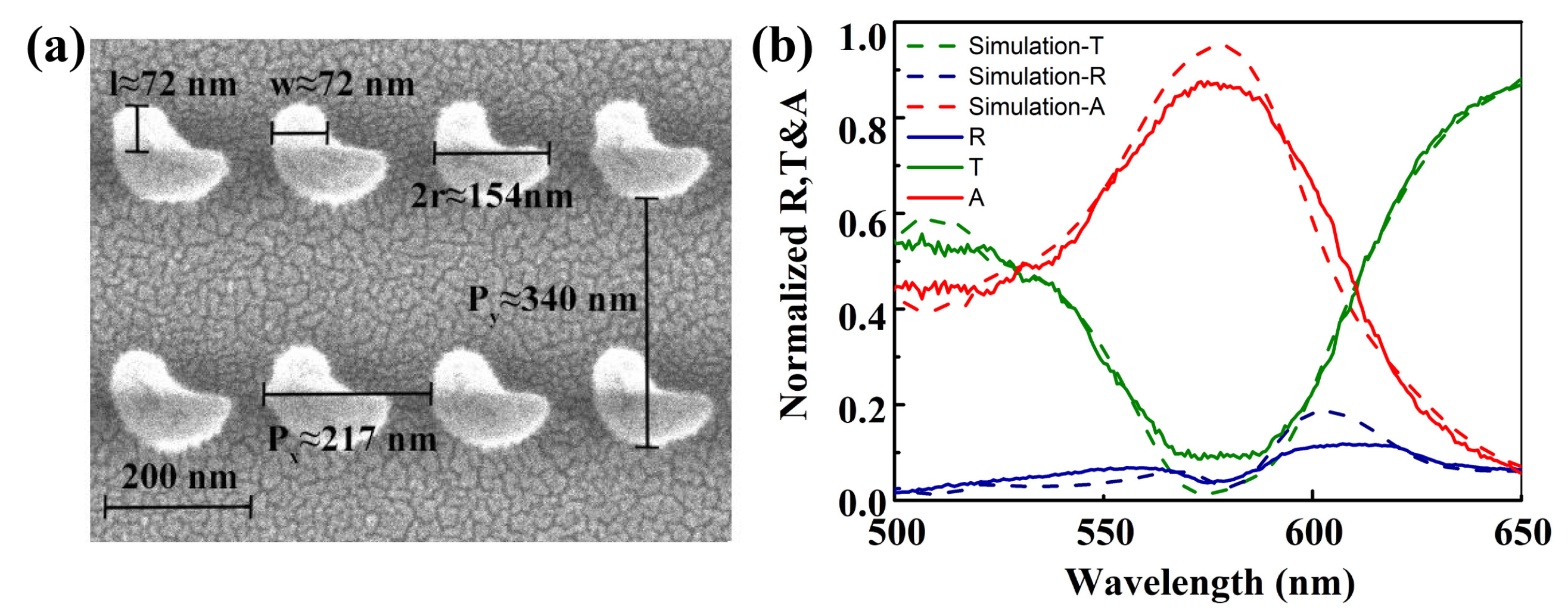Broadened Angle-Insensitive Near-Perfect Absorber Based on Mie Resonances in Amorphous Silicon Metasurface
Abstract
:1. Introduction
2. Materials and Methods
3. Results and Discussion
3.1. Numerical and Simulated Results
3.2. Experimental Results
4. Conclusions
Author Contributions
Funding
Acknowledgments
Conflicts of Interest
References
- Zhao, Q.; Zhou, J.; Zhang, F.; Lippens, D. Mie resonance-based dielectric metamaterials. Mater. Today 2009, 12, 60–69. [Google Scholar] [CrossRef]
- Chen, S.; Li, Z.; Zhang, Y.; Cheng, H.; Tian, J. Phase Manipulation of Electromagnetic Waves with Metasurfaces and Its Applications in Nanophotonics. Adv. Opt. Mater. 2018, 6, 1800104. [Google Scholar] [CrossRef]
- Chang, S.; Guo, X.; Ni, X. Optical Metasurfaces: Progress and Applications. Annu. Rev. Mater. Res. 2018, 48, 279–302. [Google Scholar] [CrossRef] [Green Version]
- Zheng, X.; Xiao, Z.; Ling, X. Broadband visible perfect absorber for sensor based on ultra-thin metamaterial. J. Mater. Sci. Mater. Electron. 2017, 28, 7739–7744. [Google Scholar] [CrossRef]
- Magdi, S.; El-Diwany, F.; Swillam, M.A. Broadband MIR harvester using silicon nanostructures. Sci. Rep. 2019, 9, 5829. [Google Scholar] [CrossRef] [PubMed] [Green Version]
- Desouky, M.; Mahmoud, A.M.; Swillam, M.A. An all silicon-based metamaterial for mid-IR energy harvesting. In Proceedings of the Photonic and Phononic Properties of Engineered Nanostructures VIII, San Francisco, CA, USA, 27 January–1 February 2018; Adibi, A., Lin, S.Y., Scherer, A., Eds.; International Society for Optics and Photonics: San Diego, CA, USA, 2018; Volume 10541, pp. 16–21. [Google Scholar] [CrossRef]
- Vismara, R.; Länk, N.O.; Verre, R.; Käll, M.; Isabella, O.; Zeman, M. Solar harvesting based on perfect absorbing all-dielectric nanoresonators on a mirror. Opt. Express 2019, 27, A967. [Google Scholar] [CrossRef]
- Zhao, X.; Wang, Y.; Schalch, J.; Duan, G.; Cremin, K.; Zhang, J.; Chen, C.; Averitt, R.D.; Zhang, X. Optically Tunable All-Dielectric Broadband Terahertz Metamaterial Perfect Absorber. In Proceedings of the 2019 44th International Conference on Infrared, Millimeter, and Terahertz Waves (IRMMW-THz), Paris, France, 1–6 September 2019; pp. 1–3. [Google Scholar] [CrossRef]
- Bosio, N.; Šípová Jungová, H.; Länk, N.O.; Antosiewicz, T.J.; Verre, R.; Käl, M. Plasmonic versus all-dielectric nanoantennas for refractometric sensing: A direct comparison. ACS Photonics 2019, 6, 1556–1564. [Google Scholar] [CrossRef]
- Bezares, F.J.; Long, J.P.; Glembocki, O.J.; Guo, J.; Rendell, R.W.; Kasica, R.; Shirey, L.; Owrutsky, J.C.; Caldwell, J.D. Mie resonance-enhanced light absorption in periodic silicon nanopillar arrays. Opt. Express 2013, 21, 27587. [Google Scholar] [CrossRef]
- Kuznetsov, A.I.; Miroshnichenko, A.E.; Brongersma, M.L.; Kivshar, Y.S.; Luk’yanchuk, B. Optically resonant dielectric nanostructures. Science 2016, 354, aag2472. [Google Scholar] [CrossRef] [Green Version]
- Kruk, S.; Kivshar, Y. Functional Meta-Optics and Nanophotonics Governed by Mie Resonances. ACS Photonics 2017, 4, 2638–2649. [Google Scholar] [CrossRef] [Green Version]
- Kivshar, Y.; Miroshnichenko, A. Meta-Optics with Mie Resonances. Opt. Photonics News 2017, 28, 24. [Google Scholar] [CrossRef]
- Ra’di, Y.; Asadchy, V.S.; Kosulnikov, S.U.; Omelyanovich, M.M.; Morits, D.; Osipov, A.V.; Simovski, C.R.; Tretyakov, S.A. Full Light Absorption in Single Arrays of Spherical Nanoparticles. ACS Photonics 2015, 2, 653–660. [Google Scholar] [CrossRef]
- Länk, N.O.; Verre, R.; Johansson, P.; Käll, M. Large-Scale Silicon Nanophotonic Metasurfaces with Polarization Independent Near-Perfect Absorption. Nano Lett. 2017, 17, 3054–3060. [Google Scholar] [CrossRef]
- Babicheva, V.E.; Moloney, J.V. Lattice effect influence on the electric and magnetic dipole resonance overlap in a disk array. Nanophotonics 2018, 7, 1663–1668. [Google Scholar] [CrossRef] [Green Version]
- Forouzmand, A.; Mosallaei, H. All-Dielectric C-Shaped Nanoantennas for Light Manipulation: Tailoring Both Magnetic and Electric Resonances to the Desire. Adv. Opt. Mater. 2017, 5, 1700147. [Google Scholar] [CrossRef]
- Sun, S.; Zhou, Z.; Zhang, C.; Gao, Y.; Duan, Z.; Xiao, S.; Song, Q. All-Dielectric Full-Color Printing with TiO2 Metasurfaces. ACS Nano 2017, 11, 4445–4452. [Google Scholar] [CrossRef] [PubMed]
- Paniagua-Dominguez, R.; Ha, S.T.; Kuznetsov, A.I. Active and Tunable Nanophotonics With Dielectric Nanoantennas. Proc. IEEE 2020, 108, 749–771. [Google Scholar] [CrossRef]
- Alaee, R.; Albooyeh, M.; Rockstuhl, C. Theory of metasurface based perfect absorbers. J. Phys. D Appl. Phys. 2017, 50, 503002. [Google Scholar] [CrossRef] [Green Version]
- Babicheva, V.E.; Evlyukhin, A.B. Resonant Lattice Kerker Effect in Metasurfaces with Electric and Magnetic Optical Responses. Laser Photonics Rev. 2017, 11, 1700132. [Google Scholar] [CrossRef] [Green Version]
- Wang, Z.Y.; Zhang, R.J.; Wang, S.Y.; Lu, M.; Chen, X.; Zheng, Y.X.; Chen, L.Y.; Ye, Z.; Wang, C.Z.; Ho, K.M. Broadband optical absorption by tunable Mie resonances in silicon nanocone arrays. Sci. Rep. 2015, 5, 7810. [Google Scholar] [CrossRef] [Green Version]
- Yang, C.Y.; Yang, J.H.; Yang, Z.Y.; Zhou, Z.X.; Sun, M.G.; Babicheva, V.E.; Chen, K.P. Nonradiating Silicon Nanoantenna Metasurfaces as Narrowband Absorbers. ACS Photonics 2018, 5, 2596–2601. [Google Scholar] [CrossRef]
- Liu, C.; Wu, T.; Liu, Y.; Li, J.; Wang, Y.; Yu, Z.; Ye, H.; Yu, L. Realization of perfect selective absorber based on multipole modes in all-dielectric moth-eye structure. Opt. Express 2019, 27, 5703. [Google Scholar] [CrossRef] [PubMed]
- Li, C.; Fan, H.; Dai, Q.; Wei, Z.; Lan, S.; Liu, H. Multipole Resonance in Arrays of Diamond Dielectric: A Metamaterial Perfect Absorber in the Visible Regime. Nanomaterials 2019, 9, 1222. [Google Scholar] [CrossRef] [PubMed] [Green Version]
- Evlyukhin, A.B.; Reinhardt, C.; Seidel, A.; Luk’yanchuk, B.S.; Chichkov, B.N. Optical response features of Si-nanoparticle arrays. Phys. Rev. B 2010, 82, 045404. [Google Scholar] [CrossRef] [Green Version]






© 2020 by the authors. Licensee MDPI, Basel, Switzerland. This article is an open access article distributed under the terms and conditions of the Creative Commons Attribution (CC BY) license (http://creativecommons.org/licenses/by/4.0/).
Share and Cite
Si, J.; Liu, S.; Yang, W.; Yu, X.; Zhang, J.; Deng, X. Broadened Angle-Insensitive Near-Perfect Absorber Based on Mie Resonances in Amorphous Silicon Metasurface. Nanomaterials 2020, 10, 1733. https://doi.org/10.3390/nano10091733
Si J, Liu S, Yang W, Yu X, Zhang J, Deng X. Broadened Angle-Insensitive Near-Perfect Absorber Based on Mie Resonances in Amorphous Silicon Metasurface. Nanomaterials. 2020; 10(9):1733. https://doi.org/10.3390/nano10091733
Chicago/Turabian StyleSi, Jiangnan, Shuang Liu, Weiji Yang, Xuanyi Yu, Jialin Zhang, and Xiaoxu Deng. 2020. "Broadened Angle-Insensitive Near-Perfect Absorber Based on Mie Resonances in Amorphous Silicon Metasurface" Nanomaterials 10, no. 9: 1733. https://doi.org/10.3390/nano10091733




